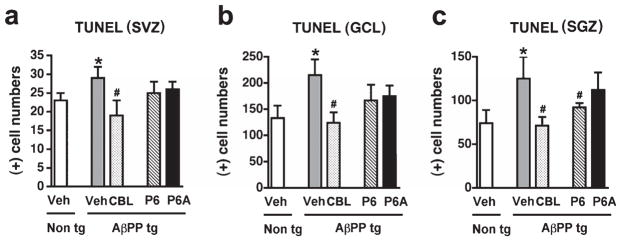Fig. 4.

Anti-apoptotic effects of Cerebrolysin across neurogenic regions in the AβPP transgenic mice. Terminal deoxynucleotidyl transferase dUTP nick end labeling (TUNEL) was performed in order to examine the comparative effects of Cerebrolysin (CBL) and Peptides 6 and 6A on apoptotic cell death. a) Analysis of TUNEL-positive cells in the subventricular zone (SVZ) of vehicle-treated non tg mice, vehicle-treated AβPP tg mice, CBL-treated AβPP tg mice, and Peptide 6-treated AβPP tg mice, respectively.) Analysis of TUNEL-positive cells in the granule cell layer (GCL) of the olfactory bulb of vehicle-treated non tg mice, vehicle-treated AβPP tg mice, CBL-treated AβPP tg mice, and Peptide 6-treated AβPP tg mice, respectively. c) Analysis of TUNEL-positive cells in the subgranular zone (SGZ) of the hippocampus from vehicle-treated non tg mice, vehicle-treated AβPP tg mice, CBL-treated AβPP tg mice, and Peptide 6-treated APP tg mice, respectively. Error bars represent mean ± SEM. (*) indicates a significant difference (p < 0.05) between vehicle-treated AβPP tg mice and vehicle-treated non tg mice and (#) indicates a significant difference (p < 0.05) between vehicle-treated AβPP tg mice and AβPP tg mice treated with CBL or Peptides 6 and 6A by one-way ANOVA and Dunnett’s post hoc test.
